






















Companies with strong omnichannel customer engagement retain roughly 89 % of their customers and enjoy a 9.5 % year-over-year increase in annual revenue.
How do they do it? By maintaining a strong, consistent voice across every channel.
That’s why a clear integrated marketing communication strategy is now essential for global players.
But not everybody gets it right.
According to the World Federation of Advertisers, 80 % of the world’s largest advertisers say IMC is a top priority, yet many struggle to execute it effectively.
You’re on the right page, though.
This article shows you exactly how the big players are using integrated marketing to turn noise into alignment for maximum impact.
Keep reading below.
Quick win: Set up a unified KPI dashboard. This centralizes performance across digital marketing, public relations, and content marketing. You get global oversight with local insights.
Boutique and enterprise agencies differ in scale, structure, and specialization.
Boutique agencies offer agility, hands-on support, and niche expertise ideal for startups and mid-sized companies.
Enterprise agencies provide integrated global campaigns, large teams, and compliance support suited for complex or multinational operations.
Boutique benefits: faster communication, direct access to decision-makers, creative flexibility, and lower retainers with strong ROI.
Enterprise advantages: cross-department collaboration, structured processes, multilingual capabilities, and consistent brand management across markets.
Key decision factors: budget, project complexity, speed requirements, and desired level of client collaboration.
Cultural fit influences partnership success; aligned values and clear communication improve campaign outcomes.
Fieldtrip combines boutique agility with enterprise scale through connected, autonomous teams managing strategy, creative, media, and performance.
The ideal partner depends on your goals, choose based on whether you need precision and flexibility or reach and structure.
Consumers expect consistent, culturally relevant experiences at every touchpoint. This relevance and consistency are what drive conversions.
To convert visitors into customers, your brand identity must be the same across content, communication, digital platforms, social media, and more.
That consistency equals improved trust and memorability.
Consistency has always been the backbone of IMC, but what’s new is how global companies operationalize it across dozens of markets and channels.
So first, you need high-performing engagement strategies as part of your integrated marketing communications (IMC) to deliver measurable results.
As we’ve seen in our work, even modest adjustments in content strategy and brand voice can shift engagement dramatically.
But only 17% of companies rate their engagement strategy as highly effective, even though 86% of buyers will pay more for a great experience.
To avoid being part of the majority that underperforms, you can use integrated marketing and see a 50% increase in ROI.
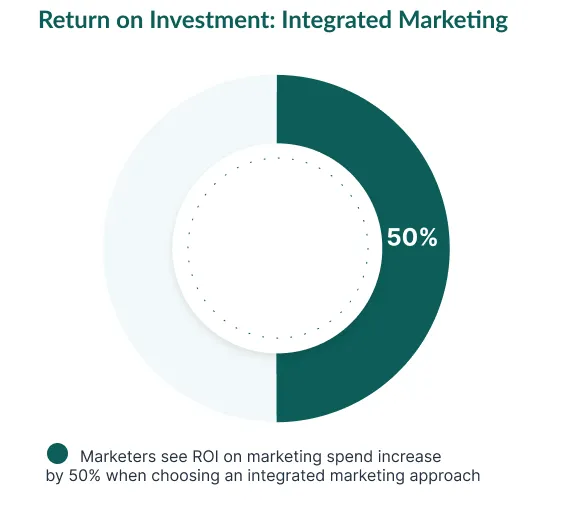
Here’s what good consistency looks like in practice.
Fieldtrip Agency delivered 750+ unique UGC assets for Native’s limited collections across four campaigns, exceeding content goals by 200% and collaborating with 50+ creators per drop.

That brings us to the next point:
In simple terms, IMC aligns marketing communication across diverse channels and digital platforms. This ensures that regional campaigns and global creatives aren’t working at cross purposes and can maintain cohesive messaging.
Check out this video for a quick explainer on what IMC is:
Inconsistency is a bigger problem than you might think.
A survey of global marketers found 70% believe better integration in their companies would deliver at least a 10% higher return on marketing investment. Basically, these companies are not maximizing integration well.
Besides, research on brand consistency shows that companies with a unified brand across platforms can see revenue lifts of roughly 23%.
So, how do you prevent fragmentation? Be consistent. Everywhere.
Basically, integrated marketing combines both digital and traditional marketing:

That means:
Let’s take each one at a time:
First, IMC coordinates content marketing, corporate communication, public relations, and paid media into a single, coherent narrative rather than separate tactical efforts.
Secondly, from an operational perspective, IMC depends on technology to work at scale. Customer data platforms such as Twilio Segment and marketing automation platforms such as Adobe Marketo help unify first-party data, orchestrate campaigns, and maintain a single view of the customer across markets.
Because you really do not want fragmented messages across regions.
IMC replaces duplication with a measurable, global voice that local teams can adapt without losing consistency.
Globalization has multiplied channels, but coherence across touchpoints remains hard to achieve.
One solution is data-driven creativity.
As an example, Fieldtrip delivered multilingual campaigns in seven European markets. It aligned content, creator partnerships, and paid social strategies to maintain a cohesive brand message across multiple platforms and 19 languages.

When you manage content marketing across regions like we did, fragmented messaging and misaligned tone can confuse your target audience and dilute customer engagement and loyalty.
Inconsistent campaigns also undermine marketing ROI and brand trust.
As markets become more complex, the value of coordinated global campaigns becomes clearer. When IMC works well, you get streamlined operations, clearer attribution, and stronger cross-border performance.
That sort of retention comes from clarity, consistency, and alignment.
Here’s another great example: the multinational food brand Heinz.
Heinz has kept its brand fresh with integrated campaigns that mix data-driven creativity and new tech. One example is the AI-powered “Tasting Dimensions” project, which used text-to-image AI to dream up playful ketchup visuals and earned huge global reach and media buzz.
Watch this video to see it in action:
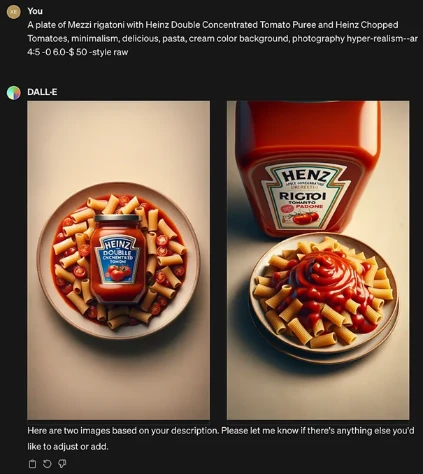
The sort of retention IMC delivers isn’t accidental. It comes from clarity, consistency, and alignment. Heinz’s own marketing research shows that IMC is three times more effective than traditional campaigns.
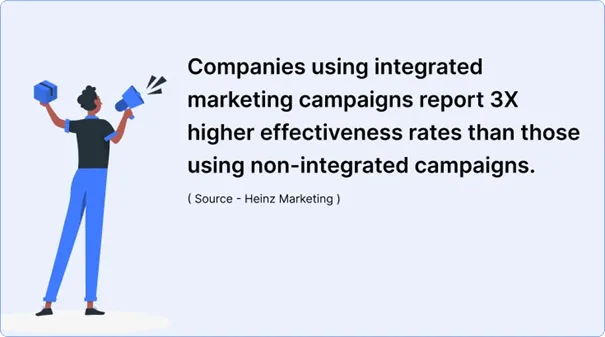
These days, technology underpins successful integrated marketing communication. You rely on tools for marketing automation, data analytics, and digital platforms.
But the real power lies in how you connect them.
The right setup aligns your marketing communication, social media channels, corporate communication, and content strategy while ensuring brand identity holds firm across geographies.
That means keeping up with the latest trends in IMC.

Tech powers global integrated communications. Analytics tools give you the visibility to measure campaign performance across markets.
AI-powered marketing automation, for example, helps with predictive audience segmentation and campaign optimization.
Besides, first-party data and martech stacks centralized in a CDP offer rich consumer insights without breaching privacy.
Smart marketers tie content strategy and digital platforms together and use performance dashboards to track ROI consistently.
This sort of cohesion means fewer blind spots and more focused, measurable global reach.
With the rise of generative AI, search is shifting from keywords to conversational prompts answered by LLMs, meaning marketing must now consider how AI systems are trained, seeded, and prompted.
Companies are responding by creating structured, credible content with clear headings, schema, and expert authorship.
They’re also expanding beyond corporate sites into LinkedIn, YouTube, guest posts, and other platforms to ensure consistent brand signals and authoritative mentions.
And that’s important because, according to Gartner, by 2026, 30% of organic search traffic will come from AI-generated results rather than traditional search engines.

Artificial intelligence and machine learning are transforming how companies handle personalization and efficiency across regions.
That means you can anticipate messaging at scale without losing relevance. You can also apply predictive analytics to audience segmentation, which helps target high-value consumers more precisely.
In global campaigns, automation tools can streamline optimization and targeting.
Digital advertising platforms that use AI to adjust bids in real time help maintain consistent performance across markets. This avoids wasted ad spend or message mismatch.
Brands employing real-time AI targeting report 20% lower cost per acquisition. If you’ll be implementing this too, your global operations will gain efficiency and clarity as a result.
Besides, your internal teams can focus on strategy while AI handles performance tweaking. And that means you get more bandwidth for creative execution.
Collecting global data is often messy, but tying it into a single strategy is critical.
Many companies struggle with inconsistent data sets across regions, which undermines both personalization and measurement.
Feeling that tension at scale makes data governance essential.
You want cohesion across local markets.
You need clear frameworks for data collection and integration that comply with GDPR in Europe and similar rules elsewhere. But maintaining privacy and personalization together isn’t simple.
Smart teams build centralized data repositories or customer data platforms. These tools allow marketers to segment audiences using first-party data while staying compliant.
Insights drawn from regional markets feed global optimizations and vice versa.
When data flows smoothly across borders, you save time and get sharper campaigns. Real-time dashboards, for example, help local teams adjust campaigns quickly while global teams monitor performance and maintain brand voice.
Creative, multi-channel content strategy is more critical than ever for engaging diverse global audiences.
Brands that orchestrate owned, earned, and paid media through unified messaging capture attention and build trust.
Content marketing, social media channels, short-form videos like YouTube Shorts, user-generated content, and search engine optimization can deliver brand identity across markets.
How does that play out in the real world? Very well, if done the right way.
Fieldtrip transformed Linktree’s global social presence, launching 8 content series and increasing organic reach fivefold in six months. This is a prime example of how innovative content across channels can drive worldwide engagement.

Video keeps pulling its weight as the most engaging format, especially in global integrated marketing communication.
Short-form videos and immersive visuals drive emotional connection and memory. It’s projected that 82% of global internet traffic will be video by 2025.
What this means for IMC: To stay relevant, we advise our enterprise clients to make video a core asset across every channel. So stop viewing videos as mere campaign add-ons.
Of course, you should align formats with your funnel:
Embed consistent brand voice and design elements so that, whether it’s TikTok, YouTube, or LinkedIn, your audience experiences the same story.
Quick win: Repurpose a single shoot into multiple assets: a 60-second hero ad, 15-second cut-downs, social stories, and even GIFs for email. That way, you can keep messaging consistent while scaling efficiency.
Global social platforms are essential for amplifying brand visibility. But local influencers bring authenticity. And that’s marketing gold.
Micro- and nano-influencers often deliver 60 % higher engagement rates compared to larger influencers.
How effective is influencer marketing? Very. 80% of marketers think so, anyway.

But it’s not just “influencer marketing works.” That’s old news.
The real trend is: influencer marketing is shifting from campaign add-on to core IMC backbone, with local creators driving global relevance.
So, here’s what we advise you:
Owned media like websites, blogs, apps, and newsletters give you control over brand narrative and support long-term customer loyalty. They’re critical to corporate communication and consumer insights gathering.
Global brands are doubling down on owned channels to reduce reliance on volatile algorithms, third-party cookies, and paid reach.
Owned channels are becoming the anchor of integrated marketing because they give control, continuity, and measurable first-party data.
Here’s how we advise you to maximize this approach:
Integrated marketing communication isn’t just about choosing the right ad format or syncing channels. For global companies, it’s increasingly becoming an organizational priority that requires structural change.
The reality is that no IMC program can succeed externally if the organization itself isn’t aligned internally.
That’s why forward-thinking enterprises are moving away from siloed brand management toward market-oriented structures.
For example, they appoint a senior IMC leader who owns strategic direction, planning, and accountability. Agencies and creative partners are then coordinated under this single point of contact, ensuring message coherence and channel integration.
Equally important is internal reorientation.
Employees, managers, and boards must all speak with one voice, reflecting the brand in their behavior and decisions. When internal stakeholders feel loyalty and ownership, they become natural amplifiers of the company’s message. And that means they’re extending IMC far beyond the marketing department.
How to do it:
Looking forward, new technologies and customer expectations will keep evolving how you plan integrated communications.
Trends like augmented reality, virtual reality, chatbots, and omnichannel journeys across online and offline touchpoints are becoming real.
You don’t want to get stuck playing catch-up.
Brands that invest smartly today in immersive experiences and seamless transitions between digital and physical engagement will win future loyalty.
The key is thoughtful adoption that preserves cultural relevance and trust.
The rise of metaverse experiences, AR, VR, and chatbots is opening fresh creative possibilities.
AR can let customers “try on” products virtually across markets. Chatbots help maintain consistency in corporate communication and customer engagement in multiple languages.
This type of tech is going to be big. Really big.
A report from Grand View Research suggests the global augmented reality market will reach USD 599.59 billion by 2030.
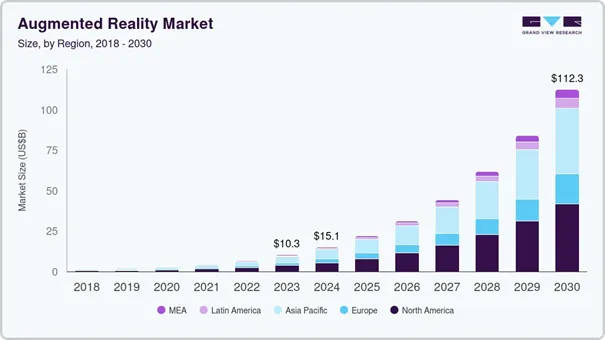
But you can’t make the most of emerging tech without a strategy.
Thoughtful integration means aligning AR or chatbot experiences with your brand identity, offering value instead of novelty. Pick pilot markets where consumer openness to innovation is higher, track engagement, iterate, then expand.
Doing this helps you keep relevance without overwhelming regional teams or compromising your brand voice.
Customers expect every touchpoint to feel connected. That requires integrating online and offline customer journeys, digital ad visibility, mobile marketing, voice search, social media channels, content marketing, and user-generated feedback.
Those who succeed treat loyalty and experience as brand building.
According to McKinsey, companies delivering seamless omnichannel experiences see 2.5 times higher customer retention than average.
Sustainable relationships come from consistency, value, and emotional connection.
Loyalty programs that tie into customer data deliver strong returns.
According to the Loyalty Program Trends 2025 report, nearly 70% of brands report increased customer engagement thanks to their loyalty initiatives, while 58% see a boost in repeat purchases.
Running global campaigns means messaging consistency matters.
You’re combining content marketing, marketing automation, digital platforms, and public relations, plus mobile marketing and SEO. And you need to maintain cultural nuance and comply with regulatory constraints.
It’s difficult not to let even one market drift from your brand voice.
However, if you’re using orchestrated planning and creative governance, you can balance global cohesion with local agility. A central campaign calendar with clear guidelines, paired with regional adaptations, helps deliver that alignment. Global brand managers and local teams coordinate more easily when tools, templates, and expectations are clear.
Aligning your message across all channels and regions depends on clear governance and structure. Your brand tone should be globally coherent yet flexible enough for local context.
How do you achieve this? There are a few proven strategies.
We advise our clients to use creative brand guidelines, message maps, and central content libraries. Tools such as Adobe Experience Manager and centralized marketing automation platforms support templates and workflows for regional teams.
You don’t want conflicting campaigns or mixed messaging. It’s better when local teams can adapt messaging within global frameworks.
Unilever, for example, has a global campaign platform.
Each regional office uses it and pulls data from the same global assets. This is great because it aligns tone and localization and avoids fragmented execution. As a result, they maintain brand visibility and consistency without sacrificing market-specific relevance.
You have choices in structuring your global marketing teams.
A centralized model delivers tighter control and consistent brand identity. Decentralized structures encourage local responsiveness.
Hybrid is often the most effective.
This gives central teams control over brand voice, strategy, and tools while regional teams lead cultural adaptation and execution. Roles like global brand managers, regional marketing directors, and local execution leads become critical.
Technology plays a big role here, too.
A shared platform, like a marketing automation system or content hub, provides visibility while enabling autonomy. This helps avoid territorial tensions or operational silos.
With a hybrid model, creative directives come from the center, regional teams adapt based on consumer insights and cultural context, and everyone remains aligned on strategic goals.
Compliance and cultural sensitivity shouldn't slow you down.
You need to know what restrictions apply to digital marketing, data privacy, and advertising in each region. There’s the GDPR in Europe, data residency rules in Asia, and content restrictions in certain markets.
You can’t treat global marketing as one-size-fits-all.
Successful teams work with legal and compliance partners and equip regional teams with localized content templates and guidelines.
No one wants regional messaging that unknowingly breaches privacy or runs afoul of local norms. Utilize consumer insights to tweak tone, images, and calls to action. Even a small wording change can avoid cultural friction and increase engagement.
Don’t think cultural adaptation matters? Think again. A report by BBN Times stated that 77% of Latin American consumers reject brands that fail to adapt to local cultures.
As for running afoul of regulations like the GDPR, that can really cost you. As Meta found out when they were fined $1.3 billion for breaching the privacy regulations.
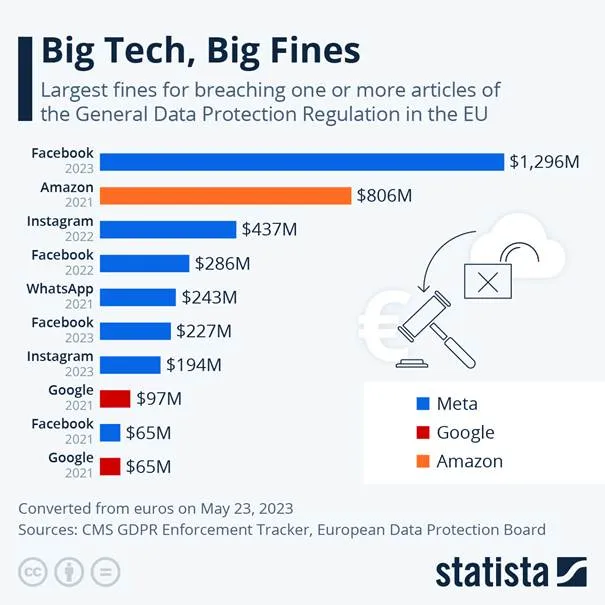
How to Measure and Optimize Global Integrated Campaigns
To understand what’s working, you need metrics that span markets and channels. Integrated marketing communications thrive when you track KPIs like engagement, reach, conversion, ROI, customer loyalty, and retention.
Digital analytics tools and marketing automation systems feed into dashboards that let you compare performance regionally and globally.
With solid measurement frameworks, you can spot underperforming markets, optimize creative, and replicate wins fast. This makes decision-making proactive and guided by real-world results.
Effective performance measurement means picking the right KPIs.
Global vs regional comparison matters, and benchmarks vary by market. That’s why we won’t tell you what KPIs to pick; it all depends on your goals and the type of campaigns you’re running.
That said, platforms such as Google Analytics 4, Adobe Analytics, or custom dashboards in BI tools like Tableau or Looker can consolidate data across campaigns and channels.
Segment performance by channel and market, then look for patterns. High engagement but low conversion could indicate weaker targeting or a message–offer mismatch.
Cross-border marketing brings complexity. Integrating data from multiple systems and countries often creates inconsistencies.
Markets vary in media consumption habits and tracking capabilities. Attribution across multi-touch journeys remains a headache.
Many marketers use multi-touch attribution models alongside controlled experiments or incrementality testing to isolate channel impact. Consolidating first-party data in a CDP helps, as does investing in global tag management and unified tracking standards.
When regional teams share schemas and reporting conventions, global analysis becomes smoother.
You need flexibility to learn fast and adapt across markets.
Real-time analytics let you tweak campaigns by region or channel on the fly. A/B testing across creative versions, messaging, or offers provides rapid feedback.
Agile teams push out iterations, compare performance, and roll out winners globally.
We’ve seen campaigns improve ROI by 15 percent when local teams had the authority to make adjustments based on dashboards and weekly performance reviews.
Combining data analytics and agile workflows means you can scale successful elements and retire underperforming ones quickly, all while respecting global brand frameworks.
Technology, data, content innovation, structure, regulation, measurement, and emerging tools all shape integrated marketing for global firms.
Consistent brand identity and seamless messaging matter. Coordinated measurement, agile optimization, and respect for regional nuance are fundamental.
Investing in AI tools, data analytics, content strategy, digital platforms, marketing automation, and first-party data capabilities pays off when paired with cultural sensitivity and clear governance.
Now is the time to keep refining and adapting.
Your next move is to build processes that let you act fast, stay coherent, and stay relevant.
Fieldtrip can help you do just that. Get in touch to find out how.
Some of the critical trends shaping integrated marketing include the growth in influencer marketing, the shift toward mobile-first audiences, and the adoption of AI-powered analytics to track audience behaviors and engagement metrics. These trends reflect a broader consumer shift toward personalization and meaningful engagement.
Strong digital strategies help unify broader marketing efforts around common goals. By aligning campaigns with broader marketing goals and measuring engagement quality instead of vanity metrics, companies improve brand loyalty, build long-term brand trust, and achieve key business milestones.
Today’s audiences expect consistency across touchpoints, quick customer service, and formats that fit their habits, like bite-sized videos and carousels in engagement. Brands that use AI-driven analytics and audience sentiment analysis can better adapt to the dynamics of consumer behavior and create deeper engagement with motivated audiences.
Influencer content has become a cornerstone of influencer marketing and a powerful part of broader marketing strategies. From luxury brands to mass-market players, companies are increasing budgets for influencer marketing to tap connections with niche audiences, foster influencer engagement, and strengthen brand communities as part of integrated campaigns.
Global enterprises treat influencer work as part of their IMC engine. They integrate content into paid, owned, and earned channels, ensure alignment with broader industry trends, and use streamlined influencer marketing workflows to coordinate creators, measure engagement levels, and tie results back to commerce with engagement and long-term brand equity.
Experts emphasize that success is about engagement quality. That means you need to build deeper engagement with expansive user bases and long-term brand trust. This reflects a broader marketing shift where influencer content fuels integrated campaigns that balance awareness with measurable performance.